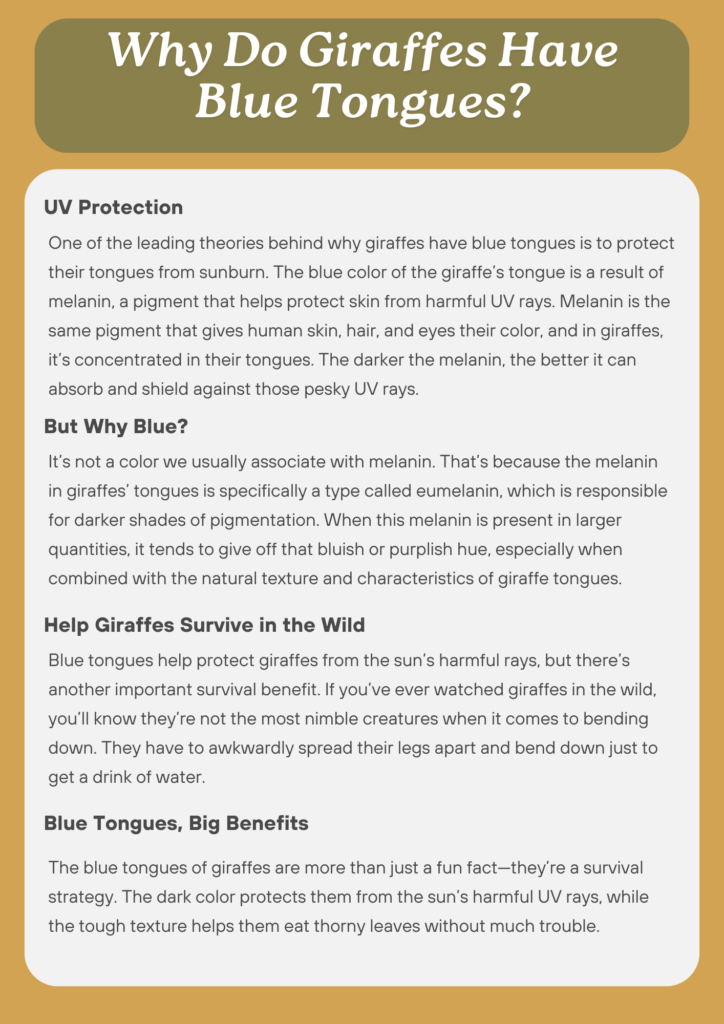If you’ve ever seen a giraffe sticking its tongue out (and let’s face it, who hasn’t?), you might have noticed something a little odd: their tongues are blue! It’s not exactly the color you’d expect from a long, elegant animal like the giraffe, right? Most of us are used to seeing tongue hues in shades of pink or red, but giraffes stand out with this striking bluish-purple shade.
So, why do giraffes have blue tongues? Well, the truth is actually pretty fascinating. Turns out, their unique tongue color is more than just a quirky trait. It has a lot to do with their diet, their environment, and even their evolutionary survival strategies.
In this article, we’re going to dive into the fascinating reason behind why giraffes have such colorful tongues. Spoiler alert: it’s not just for show. There’s an actual scientific explanation!

A Close Look at Giraffe Tongues: Not Just for Show
Alright, first things first—giraffe tongues are wild. I mean, they’re about 18 to 20 inches long (around the size of a typical ruler), and they’re prepped for some serious action. Giraffes are herbivores, and their primary food sources are leaves from trees, especially acacias. To get to these high-up, hard-to-reach leaves, giraffes need that super-long tongue. It’s like nature’s own version of a tree-climbing tool, except instead of hands, they have a very dexterous, purple-y tongue.
But, um, let’s not get ahead of ourselves. What really sets these tongues apart—besides their length—is the color. Most of the time, we expect tongues to be pinkish or reddish. But giraffes? Their tongues are this strange, dark blue or purplish-black hue. The reason for this isn’t just a fun genetic quirk, although it does make giraffes stand out in the animal kingdom. It actually serves a very practical purpose.
UV Protection: Giraffes Aren’t Just Pretty Faces
One of the leading theories behind why giraffes have blue tongues is to protect their tongues from sunburn. Yep, you read that right. Giraffes spend a lot of time munching on leaves high up in the trees, and they often have to stick their tongues out for hours at a time. This leaves their tongues exposed to direct sunlight. You might not think about it, but the sun’s UV rays can really damage delicate skin, especially if you’re out there for a long time.
Now, the blue color of the giraffe’s tongue is a result of melanin, a pigment that helps protect skin from harmful UV rays. Melanin is the same pigment that gives human skin, hair, and eyes their color, and in giraffes, it’s concentrated in their tongues. The darker the melanin, the better it can absorb and shield against those pesky UV rays. So, in a way, giraffes are using their blue tongues as a form of sunscreen. It’s like they have their very own SPF built right into their biology! And if you think about it, that’s pretty clever—especially for an animal that’s out in the sun all day long.
But Why Blue? Can’t They Just Be Brown or Black?
Great question! Why blue, though? It’s not a color we usually associate with melanin. That’s because the melanin in giraffes’ tongues is specifically a type called eumelanin, which is responsible for darker shades of pigmentation. When this melanin is present in larger quantities, it tends to give off that bluish or purplish hue, especially when combined with the natural texture and characteristics of giraffe tongues. The exact shade can vary from giraffe to giraffe, but it’s always somewhere on the bluish spectrum.
Plus, there’s something else going on. The skin on giraffes’ tongues isn’t just a regular skin texture—it’s a bit rough and covered in papillae (those little bumps you can feel on your tongue). This helps them grip onto leaves and twigs, which they need to do to pull down their food. The texture combined with the melanin creates that unique color we all recognize. Pretty wild, right?
How Does This Help Giraffes Survive in the Wild?
Alright, so we know that blue tongues help protect giraffes from the sun’s harmful rays, but there’s another important survival benefit. If you’ve ever watched giraffes in the wild, you’ll know they’re not the most nimble creatures when it comes to bending down. They have to awkwardly spread their legs apart and bend down just to get a drink of water. Because of their long necks and legs, giraffes rely on eating from tall trees where predators can’t easily reach them. That’s where the tongue comes in—it lets them access hard-to-reach leaves.
But there’s a catch: many of the trees giraffes favor (like acacias) have sharp thorns. The blue tongues, which are coated with thick skin and a layer of protective melanin, help giraffes fend off injury from those spiky thorns. The combination of their tough tongue surface and protective color means they can eat thorny, difficult plants with fewer risks. Nature really thought this one through!
Fun Fact Time! Giraffes Aren’t the Only Ones with Blue Tongues
Giraffes may have the most iconic blue tongues, but they’re not the only animals with similar traits. Other creatures, such as some species of lizards and even a few birds, have darkly colored tongues for the same UV protection reasons. Some animals, like the blue poison arrow frog, also sport blue colors for different evolutionary purposes (in their case, to warn predators that they’re toxic).
But, back to giraffes: the cool thing is that not only does their blue tongue help them survive, but it also makes them stand out in a way that’s totally unique. Think about it—how many animals do you know that have a tongue that’s practically as cool as their towering, long-necked bodies? Pretty impressive, huh?
Wrapping It Up: Blue Tongues, Big Benefits
In conclusion, the blue tongues of giraffes are more than just a fun fact—they’re a survival strategy. The dark color protects them from the sun’s harmful UV rays, while the tough texture helps them eat thorny leaves without much trouble. So next time you see a giraffe with its tongue out, don’t just think it looks funny—remember that it’s a carefully evolved tool that helps this iconic animal thrive in its environment.
So, why do giraffes have blue tongues? Simple: it’s all about survival, UV protection, and a good dose of evolutionary smarts. How cool is that?

